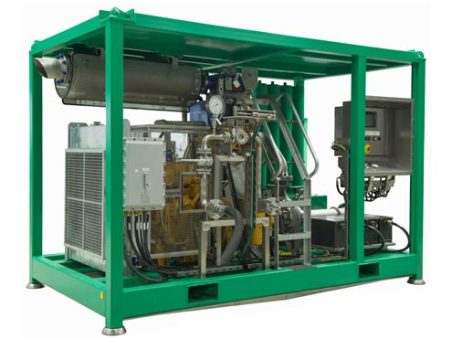The challenge
Calder was selected to design, manufacture, test and commission a new pump package to pump produced water* in the Samarang Oil Field located offshore Malaysia, as part of a redevelopment phase of the ageing infrastructure. The pump had to be powered by a gas engine, and the package also had to be ATEX Zone II rated, for use in areas where an explosive gas mixture may occur for a short time. The objective was to extend the economic viability of the oil field through enhanced oil recovery methodology. This presented Calder with a number of unique design challenges requiring innovative solutions.
*Produced water is the term used in the oil industry to describe water that is produced as a by-product along with the oil and gas. Oil and gas reservoirs often contain an amount of water which is pumped to the surface with the oil and gas. However, this water is often mostly brine and is unsuitable for use as drinking water or in agriculture, so it is re-injected back into the oil well, further enhancing the wells production capability.
The solution
An unusual constraint of this project was the complete lack of available electrical power on the rig to support the pump package. The pump package was new equipment being added to an existing development, and all the available power was being utilised for existing equipment. Calder had to design two separate and entirely new ‘black start’ systems to start the gas engine, without relying on external power. Calder would typically adopt a pneumatic starting system for a standalone (diesel powered) pump package, but this was found to be unsuitable due to the increased cranking time required for a gas engine, compared to a diesel engine. Calder investigated alternative methods and component suppliers, before designing the system in-house to incorporate the following starting systems:
- Normal conditions: Battery powered (electric) starter, using specially sourced batteries that were not only ATEX rated, but also suitable to fit into the restricted space envelope.
- Abnormal conditions (i.e. if the batteries were discharged, due to extended periods of inactivity): Hydraulic starter, incorporating banks of accumulators for storing pressurised hydraulic oil, which would provide the energy required to start the pump.
The dual starting systems also necessitated a requirement for an integrated control system to be designed by the Calder electrical engineering team. This controlled which of the two starting methods would be used based on battery condition, and then automatically switch to hydraulic start if the battery system failed to start the gas engine. Once started, the control system was designed to run as normal, without external power.
Calder was required to design a gas fuel system to meet ATEX Zone II requirements. It also had to meet a variety of operational and functional requirements stipulated by the client such that it could be used safely as part of a piece of un-staffed equipment. Calder’s design solutions included the use of actuated valves to shut off fuel supply and air supply to the engine, as well as gas monitors to detect the presence of potentially explosive gases. In addition, Calder designed some engine modifications including a secondary power take off (PTO) and a hydraulic ram to control the engine speed governor.
Researching the market found only one suitable gas engine in terms of duty, physical size and ATEX rating. However, a section of this gas engine’s exhaust manifold was not sufficiently cooled to meet the requirements of the ATEX temperature class. Calder, therefore, designed the exhaust manifold to include sufficient cooling throughout the entire exhaust manifold. In addition, it was discovered that there was not a suitable exhaust cooling system available on the market to meet the project requirements. Calder selected a cooling system intended for use with another type of engine, and modified it for use with the chosen engine.
Having never previously tested a gas engine pump in its UK test facility, Calder designed a comprehensive and safe test system. This included sourcing a liquid natural gas tank, sited in a safe area outside the building, to feed a vaporiser and pressure regulation manifold before feeding the gas into the test bay under controlled conditions. In addition, Calder installed gas monitoring equipment within the test bay area to analyse gas levels in order to maintain a safe working environment.
The result
The equipment was fully demonstrated during testing, and witnessed by the client. The equipment was proven to meet all functional and safety requirements of the project.
Get more details on our produced water injection packages.






